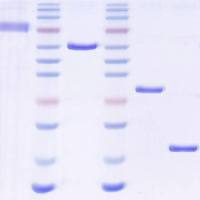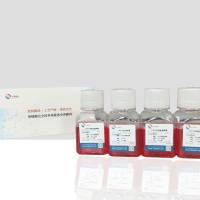Preparation of Feeder Layers And SNL Stocks
互联网
Preparation of Feeder Layers And SNL Stocks
1.1. Gelatinizing Plates
Prepare plates by covering surface with 0.1% Gelatin solution:
Plate Size (cm) Amount of Gelatin (ml)
3 2
6 4
10 9
15 18
Swirl the plates to cover the entire surface. Allow plates to gel
@ room temp. for at least 2 hours. Aspirate off all of the gelatin
directly before using the plates.
1.2. Feeder Layers
Use the 15 cm stock plates to make feeders.
1. Remove 12 mls of the media from each plate.
2. Add 360 ul Mitomycin C stock solution to each plate and
swirl to cover surface.
3. Incubate @ 37o C for 2 hours.
4. After incubation, aspirate off all of the media and wash
the cells twice with PBS, 5-10 ml per wash (enough to cover
the surface). Aspirate off all of the PBS.
5. Add 2 ml of Trypsin to each 15 cm plate. Swirl to cover
the entire surface. Incubate @ 37o C for 5 minutes.
6. Add 5 ml of media (7% FCS, 1X GPS) to each plate to
inactivate the trypsin. Suspend the cells by pipetting
up-and-down and transfer the suspension to sterile 15 ml
centrifuge tubes. Repeat the suspension process, pooling
all of the suspensions into the 15 ml tubes, until all of
the cells have been harvested. (You should be able to pool
suspensions from two 15 cm plates into one 15 ml tube.)
7. Spin the tubes for 7 minutes @ 1,000 rpm.
8. Carefully aspirate off the supernatant. Do not touch the
cell pellet. Tap each tube gently to break up the pellet.
9. Add 5 ml of media to each tube and resuspend the cell pellets.
Vigorously pipette up-and-down to insure a good
suspension. Finally, pool all of the suspensions
into one 50 ml tube. It is imperative that the
total volume of media added to resuspend the cells
be recorded; that value will be used later in calculations.
10. Transfer 200 ul of the cell suspension to a plastic vial
and add 10 ml PBS or Isoton II. Count the cells using the
Coulter Counter.
Calculating the Cell Number (only relevant if the
counter is set to count a 0.5 ml sample):
The Coulter Counter will display "XXXXX", which
= "X,XXX,X00 cells/ml"
= "X.X x 106 cells/ml"
To calculate the total number of cells, multiply
"X.X x 106 cells/ml" by the volume from which the 200 ul
aliquot was taken (see step 9).
11. We require 3.5 x 105 cells/ml. Therefore, in order to
reach this cell density, you must calculate the volume
of media into which the cells will be added. To do this,
divide the total cell number by 3.5 x 105 cells/ml.
Example:
After centrifuging my cells and aspirating off the media,
I have 3 cell pellets to resuspend. Therefore, I use a total
of 15 ml of media to resuspend the 3 pellets. I then count
a 200 ul aliquot of the suspension, and the Coulter Counter
displays 6 9 5 7 9
= 6,957,900 cells/ml
= (6.9 x 106 cells/ml) x 15 ml (total
volume used to resuspend cells)
= (1.035 x 108 cells total) / (3.5 x 105 cells/ml)
approx. = 296 ml media needed
12. Once you have determined the required volume of media, add
the cell suspension to that volume of media and shake
to uniformly distribute the cells.
13. Check to see if the proper cell density has been reached
by taking a 200 ul aliquot of the media and counting as
before. However, when calculating the total cell number,
be sure to use the total volume of media to which the cells
were added.
Example:
From the previous example, we calculated that 296 ml of
media was needed to reach the required cell density. Upon
recounting to check the density, the Coulter Counter
displayed 0 4 3 5 8
= 435,800 cells/ml
= (0.43 x 106 cells/ml) x 296 ml (total volume to
which cells were added)
= (1.2728 x 108 cells total) / (3.5 x 105 cells/ml)
approx. = 364 ml media needed
If the total cell count is still too high to give the
desired density, add the determined amount of media that will dilute
the cells to the proper density (i.e., the difference between the
volume of media needed for the first count and the volume
needed for the second count).
Example:
From the second determination above, we found that
364 ml of media is needed to obtain the desired cell
density. Since we have already added 296 ml of media,
we need only add another 68 ml.
364 ml - 296 ml = 68 ml of media to be added
14. Once the required cell density (3.5 x 105 cells/ml) has
been reached, aliquot the prepared Feeder Media into the
size and numbers of feeder plates needed (remembering to
use plates that have been pretreated with the gelatin).
Swirl the plates to uniformly distribute the cells.
Size of Plate (cm) Amount of Media to Aliquot (ml)
15 30
10 12
6 4
3 (or 6-well) 2
24- or 4-well 0.5
15. Place the feeders in the 37o C incubator, labelling the tray
with "Feeders" and the date.
SNL (STO-Neo-LIF) Stocks
Use a confluent 10 cm plate to prepare stock plates. Gel 15 cm
plates for the stocks and one 10 cm plate for the passage plate.
1. Aspirate off all of the media and wash the cells twice with
PBS, 4-7 ml per wash (enough to cover the surface). Aspirate
off all of the PBS.
2. Add 0.8 ml Trypsin to the plate; swirl to cover the
entire surface. Incubate @ 37o C for 5 minutes.
3. Add 10 ml of media to the plate to inactivate the trypsin.
Vigorously pipette up-and-down to suspend the cells.
4. Determine the total volume of media that will be needed for
the stock plates based on the following:
Size of Plate (cm) Amount of Media to Aliquot (ml)
15 30
10 12
5. Add the cell suspension to the required volume of media.
Shake the bottle to insure a uniform distribution of cells.
6. Aliquot the STO-Neo Media into plates in the volume specified
for each size of plate (see step 4). Remember to use plates
that have been pretreated with gelatin.
7. Place the stock plates in the 37o C incubator, labelling
the tray with the clone number (e.g., SNL 76/7), the passage
number, and the date.
NOTE: The 15 cm plates will be used upon confluence to prepare the feeder
plates. The one 10 cm plate will be used to maintain the cell line through
a number of passages.
From the Laboratory of Dr. Allan Bradley
Baylor College of Medicine, Houston, Texas






